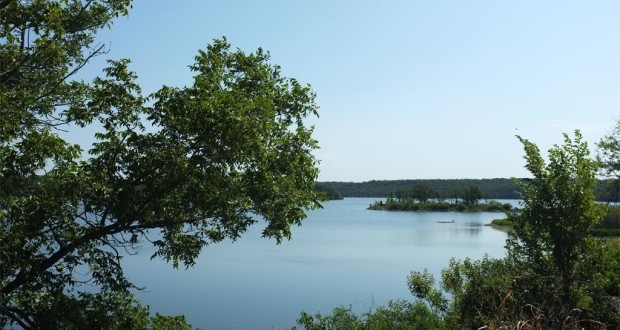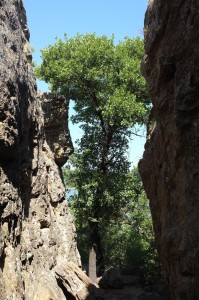An out-and-back Primitive Camping Trail of five miles roundtrip offers the most interesting landscape. It climbs down from the Cross Timbers camping area along a rocky ledge that overlooks the lake. The rough and rocky trail is lined with patches of prickly pear cactus and black-jack and post oaks, whose roots crisscross the path. Several broad vistas open up on the thick forest below and Lake Mineral Wells in the distance. After about a mile, the trail climbs back up and flattens out as it crosses and follows the loops of the Cross Timbers Back Country Trail at several points. The rest of the way to the primitive camp sites, it becomes a narrow dirt path through a mix of forest, savannah and prairie.
The nested loops of the Cross Timbers Back Country Trail stretch out to about 10 miles. Designed for both hikers and horses, the trail varies from a broad, grassy road to a narrower sandy path with occasional patches of loose, broken rock, crossing Rock Creek at several points. The nested loops enable you to create a hike or ride to suit your needs.
By hiking the first half of the Primitive Camping Trail, then returning by one of the Back Country Trail loops, you get a greater mix of terrain and avoid having to retrace your steps. On the return trip, you briefly stroll past the bunkers of a military “impact area“.
In addition to the back country trails, a Trailway runs through part of the park, following 20 miles of abandoned railroad bed between Mineral Wells and Weatherford. It crosses through both grass savannah and brushy forest in between the ranches, farms and communities it passes along the way.
The lake, created by an earthen dam, is fed by Rock Creek and covers 646 acres. The area is home to about 170 bird species – from Yellow-crowned Night Herons, Barred Owls and Red-shoulder Hawks to winter visitors such as Hooded Mergansers and Wood Ducks that frequent “Lost Lake” near Rock Creek. The park lies at the confluence of the state’s eastern and western bird communities, as described in its interpretive guide:
White-eyed Vireo, Red-eyed Vireo and Prothonotary Warber near or reach their western limit here in north Texas, while the Rufous-crowned Sparrow and Black-crested Titmouse are examples of those reaching their eastern limit. This mix of eastern and western species includes both Ladder-backed and Downy Woodpeckers as well as Ruby-throated and Black-chinned Hummingbirds … Painting Buntings and Harris’s Sparrows are both common here in proper season and habitat.
On the opposite end of the lake, the park road ends in a playground for rock climbers called Penitentiary Hollow. As you walk down the path, you come to two stunning overlooks of the lake, set off by a short a timber-and-stone fence. Just behind the second fence, a set of stone stairs takes you down into the cool hollow, framed by steep rock walls and boulders. You’ll come across climbers working their was up the rock faces and rappelling down from the top. (Climbers have to register at the park office and sign a liability waiver.)


You must be logged in to post a comment.